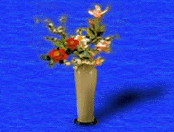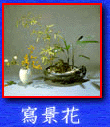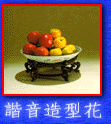
![]()


![]()

Classical Chinese flower arranging has an ancient history. Methods and techniques of arrangement have varied greatly along with aesthetic values over the years, as have preferred flower varieties. But a list of the most popular styles of arranging down through the centuries would be sure to include offertory flowers for religious ceremonies; the classical, full-bodied court flowers; decorative flower arrangements for display at banquets; intellectual arrangements; the free-style compositions found in the Buddhist meditation halls of the Five Dynasties; the expressionist works of the Yuan Dynasty; the magnificent neo-intellectual flowers; the literati stylized arrangements and the neoclassical forms of the Ming; and the realistic arrangements, literati stylized arrangements, homophonous flower arrangements taking their names from likesounding auspicious words and expressions, vegetable and fruit arrangements, and the popular intellectual flower arrangements, all of which gained prominence during the Ching Dynasty. These styles, and many others, are on display at this exhibition.
![]()

Intellectual flower arrangements are product of the aesthetic values that developed under the rationalism of the Sung Dynasty. Intellectual arrangements emphasize such themes as reason, idealism, and benevolence, and have been used as a vehicle for expressing the artist's most cherished beliefs, his philosophy of learning, his character, or his view of the world. Intellectual arrangements were most commonly displayed in vases and included pine, cedar, bamboo, plum blossoms, orchids, osmanthus, camellia, narcissus, and other flowers characterized by plainness and simplicity. Structurally, intellectual flower arrangements emphasized purity, clarity, and sparseness. The line network created by the interplay of leaves and branches, and the specific proportions in which the different elements of compositions were combined were also major hallmarks of mainstream intellectual floral arrangements during the Sung Dynasty. This composition, an excellent example of the intellectual school, is marked by the sharp, vigorous clarity of its lines and a disproportion between the branches and the vessel that contains them.
![]()

Originating in the Sung Dynasty, intellectual flower arrangements placed emphasis on logic and reason, and served as a vehicle for expressing the arranger's ethical views and benevolent intentions. These compositions underwent rapid development and took on a more dynamic character during the Ming Dynasty, when they became known as neo-intellectual flower arrangements. The neo-intellectual arrangements of the Ming Dynasty can be grouped into three categories, according to the time in which they appeared: majestic intellectual arrangements, literati arrangements, and neo-classical arrangements. This composition belongs to the earliest category. The flowers are lush and abundant, and are centered on a perpendicular, vertically rising component. Miscellaneous flowers on all sides lend an aura of power and grandeur, in the best tradition of the palace flower arrangements of the same era. Compositions of this type later found their way to Japan, where they became the ancestor of the Ikenobo type of flower arrangements.
![]()

Popular during the Yuan Dynasty and the early Ching, expressionist flower compositions provided the men of letters with the means to vent their personal frustrations and relieve their inner cares and anxieties. Feeling or emotion was the governing factor in every expressionist arrangement. Instead of being strictly defined, structure was more of a spontaneous process which unfolded as the work progressed. Solitude, isolation, and sorrow were the most common themes, conveyed by plants and flowers selected for their lofty, noble character, and by dried wood, ling chih fungus, scepters, and peacocks' tails. Another Characteristic was the total absence of inhibition and restraint, of which the "free style" expressionist arrangements are the best example. In this composition the arranger has made use of lotus, bamboo, and dried ling chih fungus to convey his theme of lofty isolation and purity.
![]()

The chief characteristic of realistic flower arrangements is their faithful reproduction of true-life nature. Through the use of ingenious potted flower creations they can be made to depict scenes as diverse as bamboo hedgerows in country farms and the grand panorama of fall descending upon a majestic mountain range. Originating in the Tang Dynasty and reaching the peak of their popularity in the Ching, realistic arrangements strove, as Shen San-pal put it, to "make the viewer feel the breath of the wind and the soft splash of the raindrops." The theme of this composition is the balmy wind and green vitality of early summer. Perfectly balanced and impeccably proportioned, it represents the best of classical realism.
![]()

Fruit and flower arrangements embodying the sounds of auspicious words and expressions uttered on festive or joyful occasions were a major trend in folk floral arranging during the Ching Dynasty. Examples of materials used include cypress, Chinese evergreen, lotus and the lily, the words for which were phonetically identical to those in the congratulatory wedding message pai nien ho ho, or "a harmonious union lasting a hundred years." Chinese floral arrangements thus became a unique art form, appealing not only to the eyes but to the ears as well.
![]()
[preface] [
styles] [religious] [palace]
[literati] [folk]
[9 pricniples] [significance]
[preveration] [vessels]
[appreciatin]
[Pavilion of Taiwan,
R.O.c] [Cultures]
[Council For Cultural
Affairs]